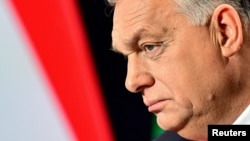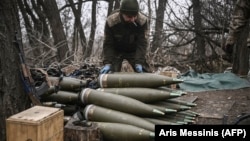
Welcome to Wider Europe, RFE/RL's newsletter focusing on the key issues concerning the European Union, NATO, and other institutions and their relationships with the Western Balkans and Europe's Eastern neighborhoods.
I'm RFE/RL Europe Editor Rikard Jozwiak, and this week I'm drilling down on two issues: how the EU overcame a Hungarian veto and the heated debate over Ukrainian food.
Brief #1: The EU Finally Agrees To Fund Ukraine
What You Need To Know: The EU summit on February 1 was supposed to be a difficult one. But after an early morning start, there was clear unanimity among EU leaders well before noon: The bloc would provide Ukraine with 50 billion euros ($54 billion) of grants and loans for the next four years.
With Hungarian Prime Minister Viktor Orban spectacularly vetoing a deal at the Brussels summit in December, it's come at just the right time for Ukraine. The U.S. Congress has so far failed to agree on more funding for the war-torn country, and Kyiv has said it's running low on funds.
On the surface, it seems that Orban lost this time around, underestimating the other 26 member states' resolve and, in the end, only managing to extract a few concessions. He will not get any vetoes over the annual disbursements of money for Ukraine between 2024 and 2027 -- something that had been talked about as a possible concession for Orban -- and he won't see any of the money meant for Budapest that the European Commission has frozen over concerns about Hungary's democratic backsliding. The EU funds will start going to Ukraine as soon as March, with a first tranche of 1.5 billion euros.
Deep Background: Orban, however, claimed "mission accomplished" in a tweet after the meeting, noting that "Hungary's funds will not end up in Ukraine" and that there would be "a control mechanism at the end of the first and second years." (To be clear, EU money meant for Hungary has never been diverted to Ukraine, and the control mechanism Orban is referring to is wide open to interpretation.)
The best way to digest all of this is to look at the EU summit conclusions that were agreed on by all leaders. There were two crucial paragraphs. The first of these says that "on the basis of the commission's annual report on the implementation of the Ukraine facility, the European Council will hold a debate each year on the implementation of the facility with a view to providing guidance. If needed, in two years, the European Council will invite the commission to make a proposal for review in the context of the new MFF (the multi-financial framework is the long-term EU budget)."
Whether this is a "control mechanism" or not, it's pretty clear that Hungary didn't get the vetoes it wanted. An annual report by the European Commission is not a veto, nor is a yearly debate among leaders in the European Council, which defines the political direction and priorities of the EU. And in order to trigger a review, all 27 EU member states must agree. That means some of Ukraine's greatest supporters, such as the three Baltic states, can now simply prevent a review if they feel it isn't necessary.
And then there is the word "review" itself. While Hungary could interpret the process as a veto, others don't, showing once again the EU's mastery of semantic gymnastics in order to achieve a compromise.
Drilling Down
- As an illustrative anecdote, diplomats pointed to the agreement the EU struck at the end of 2022 over the price cap on Russian oil. At the time, it was settled at $60, even though more hawkish EU member states such as Poland wanted a lower figure.
- The promise that the European Council would hold reviews every other month helped convince Budapest, which perhaps took it to mean proper negotiations and potential vetoes over the price. Nothing like that has ever happened, however, and the price cap remains at $60 to this day. In this case, a review has meant just regular updates and not much more.
- The second relevant paragraph is a single sentence at the end of the summit conclusions that states that "the European Council recalls its December 2020 conclusions on the application of the conditionality mechanism."
- The conditionality mechanism being referred to was the rule change, agreed for the EU budget of 2020-27, that meant money could be withheld from member states if there was a fear that it was being misused -- which is exactly what the European Commission has done with Hungary.
So, what are the takeaways here?
- After speaking on background to officials in Brussels, the deal on the Ukraine aid package can also be interpreted as the member states gently putting pressure on the commission to unfreeze at least a portion of the 10 billion euros that is being withheld from Hungary. Or at least an urging to loosen up on the conditions that Hungary has to fulfill to get the money.
- It's possible that cash will start flowing to Hungary in the spring, especially since the European Parliament -- as a body, one of Orban's fiercest critics -- will soon go from legislative mode to election mode as EU-wide polls in June are approaching.
- It's also possible that, with Hungary coming on board, Ukraine's enlargement process might be slowed down -- something that Budapest would certainly welcome. It could be that the intergovernmental conference for Ukraine, which would mark the de facto official opening of accession talks, won't happen in March as Kyiv is hoping for but after the EU elections, so in the summer or even the fall.
- Despite not getting quite what he wanted, the whole affair has been a boost for Brand Orban. Ahead and during the summit, the two most spoken words were "Viktor" and "Orban." The Hungarian leader is perhaps the best-known populist politician in the bloc at the moment, and his talking points about sending less money to Ukraine and the need for peace talks might appeal to more Europeans than just his Hungarian faithful.
- If Euroskeptic parties do well in the European Parliament elections, Orban could see his star rising even higher once again.
Brief #2: The Problem With Ukrainian Food
What You Need To Know: The European Commission last week decided to renew the suspension of import duties and quotas on Ukrainian (and Moldovan) exports into the European Union. Known as Autonomous Trade Measures (ATMs), they have been crucial in supporting Ukraine since Russia's full-scale invasion in February 2022.
But while the suspension was universally welcomed by the 27 EU member states back in 2022, there are now considerable grumblings in the bloc, especially among Ukraine's immediate neighbors. They have complained that the measures have meant their domestic markets are flooded with cheap Ukrainian agricultural goods, threatening the livelihood of their own farmers.
Despite the opposition to the continued suspension of import duties and quotas, the ATMs are expected to be green-lit by EU member states later in the year. Unanimity isn't required for this: Only a qualified majority of 55 percent of the member states, comprising 65 percent of the total EU population, is needed for adoption.
This doesn't, however, mean that Ukrainian goods will flow freely into the bloc quite yet. It is Poland -- incidentally, one of Kyiv's biggest supporters during the war -- that is putting on the brakes. Back in May 2023, Poland, followed by Hungary, Slovakia, and Bulgaria, unilaterally shut their borders to all Ukrainian goods after complaining about the glut of food produce. The European Commission then found a temporary solution, allowing wheat, maize, rapeseed, and sunflower seeds from Ukraine to transit "unsealed" through those four countries, plus Romania, to the rest of the bloc and to destinations around the world.
The increased imports of Ukrainian goods came as Russia drastically curtailed Ukraine's lucrative Black Sea trade, and then, later that summer, backed out of a Turkey-brokered deal that had allowed ships to use a limited number of Ukrainian ports for the delivery of grain. And while Ukrainian ships continue to make the journey by hugging the Romanian and Bulgarian Black Sea coasts, the majority of food is still rerouted over land via the EU.
Deep Background: This temporary solution was not extended in September 2023, resulting in Poland unilaterally banning all Ukrainian products from entering its market. While Warsaw did still allow the transit of produce, long queues on the Polish-Ukrainian border meant more bad blood between Warsaw and Kyiv and also between Poland and the EU. The move by the Polish government, led by the right-wing Law and Justice party, was seen by many at the time as a play for votes, especially among the powerful farming sector, ahead of parliamentary elections in October 2023.
However, the new, more pro-EU government, which came into power in December, has not backed away from the restrictive policy, and the unilateral ban remains in place. Poland's new agriculture minister, Czeslaw Siekierski, is a member of the Polish People's Party, a junior partner of the government and the country's main agrarian party. In early January, Siekierski wrote a letter to the European Commission opposing the continued suspension of duties and quotas. He wrote that "the immediate liberalization of imports serves not so much the overall economy of Ukraine as it contributes to the increased profits of a small group of oligarchs, often locating their capital outside Ukraine."
Drilling Down
- At the same time, Warsaw has been constructive, opening up to the possibility of allowing Ukrainian produce back on its domestic market. Warsaw is largely driven by the fear that, sooner or later, Brussels would drag Poland to court for taking unilateral trade measures that affect the bloc's common single market.
- After intense negotiations between Polish officials and the European Commission, a number of "safeguard measures" have been put into place for when the new ATM kicks in on June 6. The aim is that this should allow Warsaw to eventually drop the ban and reassure its farmers that they are "protected."
- Poland has long highlighted how much poultry, eggs, and sugar the bloc imports. And, according to the European Commission's own figures, Warsaw has a point. Take poultry as an example. In 2021, when the normal tariffs still applied, the bloc was importing 86,000 tons a year. In 2022, with the new liberalization measures in place from June, that figure increased to 138,880 tons. In 2023, it rose again, with 200,000 tons of poultry being imported. There were similar increases in the trade volumes for eggs and sugar.
- As a solution, the European Commission has suggested a mechanism for automatic tariffs. That would mean if imports of poultry, eggs, or sugar between June and December 2024 rose to a certain level, additional tariffs on Ukrainian agricultural products would be imposed within a week.
- The devil is in the details, in particular what that level should be. The European Commission first suggested that the threshold should be the amount of poultry, eggs, or sugar imported in 2023. But considering that last year was a record year for imports, Warsaw argued that the threshold was too high. A compromise was made, with the agreed threshold based on the average of 2022 and 2023 imports, which increases the likelihood of tariffs kicking in.
- The European Commission also agreed on simpler procedures for applying an emergency brake in the form of import restrictions on products other than poultry, eggs, or sugar. This essentially means that it is deemed sufficient for one EU member state to demonstrate destabilization in its own market, instead of having to prove that it is a problem for the entire EU.
- While Poland was initially alone in pushing for safeguard mechanisms, Hungary and Slovakia, which both share a border with Ukraine, have since joined. The move also coincided with farmers taking to the streets in Belgium, France, and Germany over rising production costs (not directly related to Ukraine) and the EU stepping away from a trade deal with Mercosur, a bloc made up of Argentina, Brazil, Paraguay, and Uruguay, that would have allowed for cheap food imports from South America.
Looking Ahead
The European Union is gearing up for more sanctions against Russia. Over the weekend of February 3-4, ambassadors of EU member states were discussing a new package with European Commission officials that will coincide with the second anniversary of Russia's full-scale invasion on February 24. The new measures would largely consist of asset freezes and visa bans against Russian officials.
The European Parliament will meet in Strasbourg this week, and on February 7, lawmakers will debate the recent mass arrests of opposition figures in Belarus. A nonbinding resolution will be voted on the following day, and the chamber is expected to call for more restrictive measures against Minsk.
That's all for this week. Feel free to reach out to me on any of these issues on Twitter @RikardJozwiak, or on e-mail at jozwiakr@rferl.org.
Until next time,
Rikard Jozwiak
If you enjoyed this briefing and don't want to miss the next edition, subscribe here.





